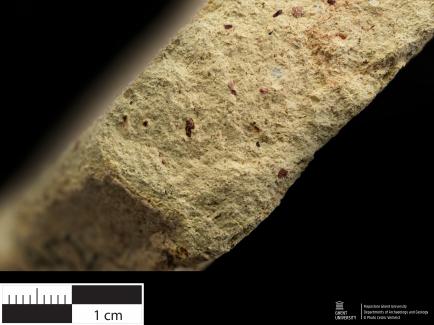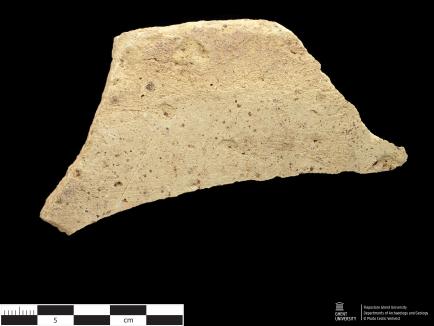Post Medieval - Ceramic building material (7.CBM.BE.0002)
Hand specimen pictures (macro & binocular)
Thin section picture
Find location
- Category
- Ceramic building material (Post Medieval)
- Fabric name
- Chronology
- Post Medieval > Modern > 1750-1800
- Dating method(-s)
- morphology, historical sources
- Potters' mark
- No
- Additional information
- biscuit (waster) tile fragment; semi-finished tile; referred to as "rough fired ware"
Find location
- Site type
- Pottery production
- Location
- Belgium; West-Vlaanderen; Brugge
- Site name
- Brugge, Arsenaalstraat
- Excavation or Survey Team
- Stedelijke Archeologische Dienst Brugge
- Additional contextual information
- attributed to the faience/majolica workshop/pottery company of Hendrik Pulinx; excavation/site code BR78/ARS; excavation location "Minnewater kasteel"
- Slip
- No
- Slip color
- Glaze
- No
- Glaze type
- Glaze color
- Glaze additives
- Additional information
- Slip
- No
- Slip color
- Glaze
- No
- Glaze type
- Glaze color
- Glaze additives
- Additional information
- Surface color
- white, beige
- Surface texture
- Smooth
- Fracture color
- beige white
- Inclusions (non-plastics/tempering)
- quartz, red fired clay grog fragments
- Matrix and voids
- voids are absent
- Diagnostic features
- Additional information
- sample BR_ARS_ST2 (no thin section)
- Sample type
- Building material (decorative, construction)
- Inventory number
- 7.CBM.BE.0002
- Collection
- Archaeological Department, Ghent University
- Donating institute/person
- Raakvlak, Onroerenderfgoeddepot De Pakhuizen
- Host collection
- Raakvlak, Onroerenderfgoeddepot De Pakhuizen
- Other samples available
- No
- Sample collection method
- Archaeological Excavation
De Witte 1978
- Full reference
-
De Witte H. 1978. Arsenaalstraat: 18de-eeuwse faïenceindustrie. Het Brugs Ommeland 18, 4: 307.
Van Den Abeele 1986
- Full reference
-
Van Den Abeele A. 1986. De faiencefabriek aan het Minnewater te Brugge (1750-1818). Handelingen van het Genootschap voor geschiedenis 123, 1-2: 61-105.
Cite this page as: Flepostore - https://flepostore.ugent.be/ceramics/7-cbm-be-0002
Last modified: 2024-04-24.



